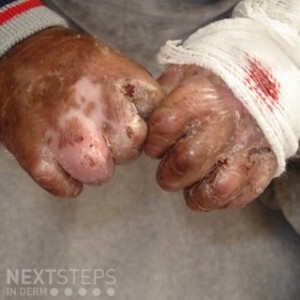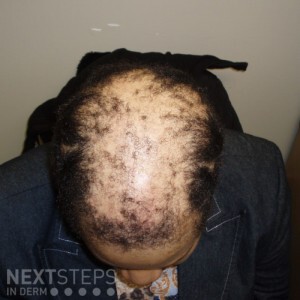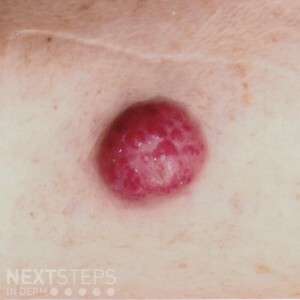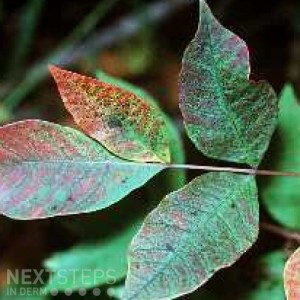Epidermolysis Bullosa – Friday Pop Quiz 11/8
 The picture shown is considered to be diagnostic for what type of epidermolysis bullosa:
A. Junctional epidermolysis bullosa- Non Herlitz type
B. Junctional epidermolysis bullosa- Herlitz type
C. Dowling-Meara form of Epidermolysis Bullous simplex
D. Dominant dystrophic epidermolysis bullosa
E. Recessive dystrophic epidermolysis bullosa
To find out the correct answer …
The picture shown is considered to be diagnostic for what type of epidermolysis bullosa:
A. Junctional epidermolysis bullosa- Non Herlitz type
B. Junctional epidermolysis bullosa- Herlitz type
C. Dowling-Meara form of Epidermolysis Bullous simplex
D. Dominant dystrophic epidermolysis bullosa
E. Recessive dystrophic epidermolysis bullosa
To find out the correct answer …
 The picture shown is considered to be diagnostic for what type of epidermolysis bullosa:
A. Junctional epidermolysis bullosa- Non Herlitz type
B. Junctional epidermolysis bullosa- Herlitz type
C. Dowling-Meara form of Epidermolysis Bullous simplex
D. Dominant dystrophic epidermolysis bullosa
E. Recessive dystrophic epidermolysis bullosa
To find out the correct answer …
The picture shown is considered to be diagnostic for what type of epidermolysis bullosa:
A. Junctional epidermolysis bullosa- Non Herlitz type
B. Junctional epidermolysis bullosa- Herlitz type
C. Dowling-Meara form of Epidermolysis Bullous simplex
D. Dominant dystrophic epidermolysis bullosa
E. Recessive dystrophic epidermolysis bullosa
To find out the correct answer … Continue reading "Epidermolysis Bullosa – Friday Pop Quiz 11/8"


 Derm In-Review Advisory Council Member, Dr. Ramya Kollipara, searched the journals so that you don’t have to! She reports on important take-aways from different dermatology journals for the months of October, November, and December of 2018.
It is key to keep in mind that “important” is subjective and what is contained in this review is one person’s view of what should be remembered from …
Derm In-Review Advisory Council Member, Dr. Ramya Kollipara, searched the journals so that you don’t have to! She reports on important take-aways from different dermatology journals for the months of October, November, and December of 2018.
It is key to keep in mind that “important” is subjective and what is contained in this review is one person’s view of what should be remembered from …  The best diagnosis of this type of cicatricial alopecia shown in this image is:
A. Chronic cutaneous lupus erythematosus.
B. Lichen planopilaris
C. Central centrifugal cicatricial alopecia
D. Pseudopelade of Brocq
E. Alopecia mucinosa
To find out the correct answer and read the explanation, click here.
Brought to you by our brand partner Derm In-Review
…
The best diagnosis of this type of cicatricial alopecia shown in this image is:
A. Chronic cutaneous lupus erythematosus.
B. Lichen planopilaris
C. Central centrifugal cicatricial alopecia
D. Pseudopelade of Brocq
E. Alopecia mucinosa
To find out the correct answer and read the explanation, click here.
Brought to you by our brand partner Derm In-Review
…  Biopsy of this lesion reveals a poorly-defined dermal mass of small blue monomorphic round cells with scant cytoplasm and nuclear molding. Which histologic stain is most helpful in distinguishing this lesion from small cell lung carcinoma?
A. CK20
B. TTF-1
C. Chromogranin
D. Synaptophysin
E. Somatostatin
To find out the correct answer and read the explanation, click here.
Brou …
Biopsy of this lesion reveals a poorly-defined dermal mass of small blue monomorphic round cells with scant cytoplasm and nuclear molding. Which histologic stain is most helpful in distinguishing this lesion from small cell lung carcinoma?
A. CK20
B. TTF-1
C. Chromogranin
D. Synaptophysin
E. Somatostatin
To find out the correct answer and read the explanation, click here.
Brou …  Match the photo to the plant identified:
A. Poison ivy
B. Gingko
C. Poison oak
D. Mango leaves
E. Poison sumac
To find out the correct answer and read the explanation, click here.
Brought to you by our brand partner Derm In-Review, a product of Sanovaworks.
…
Match the photo to the plant identified:
A. Poison ivy
B. Gingko
C. Poison oak
D. Mango leaves
E. Poison sumac
To find out the correct answer and read the explanation, click here.
Brought to you by our brand partner Derm In-Review, a product of Sanovaworks.
…